Disclosure: This post may contain affiliate links. I may earn a small commission for my endorsement, recommendation, testimonial, and/or link to any products or services from this website.
Tall and flaky, these Southern Buttermilk Biscuits are just like the old-fashioned buttermilk biscuits from Grandma’s kitchen! They’re golden brown and slightly crisp on the outside, with light, airy layers on the inside. Today I’m showing you the step-by-step process to make a batch of the best homemade biscuits in just 10 minutes!
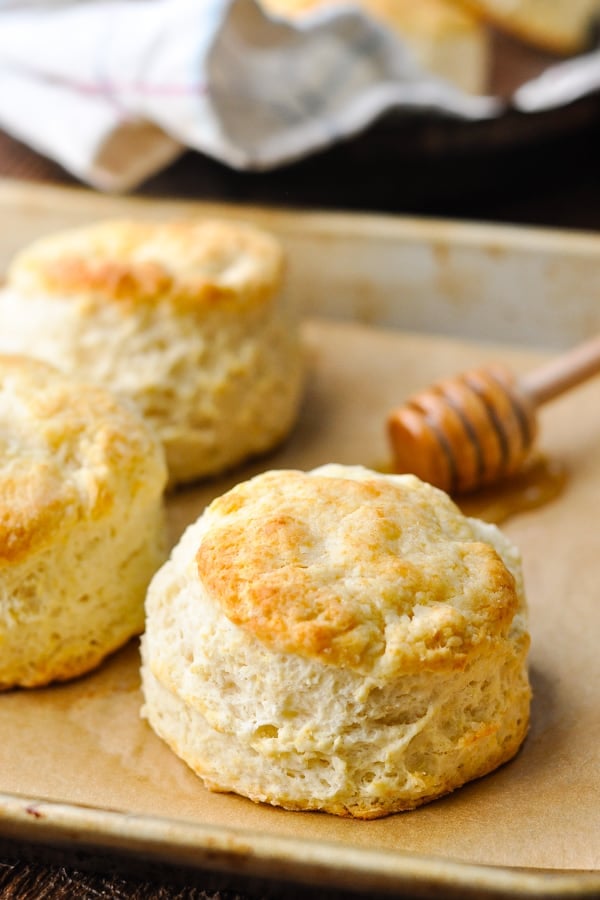
Table of Contents
Southern Buttermilk Biscuits
Buttermilk biscuits are a way of life in the South, and every home cook has her favorite version. The perfect Southern biscuit is a combination of crispy and golden brown on the outside, but tender and light on the inside. The biscuits are puffy and tall, not dense or flat, and exhibit that hard-to-achieve cross between a tender crumb and flaky layers.
In the Southeastern United States, “biscuits” are typically soft-leavened quick breads, similar to scones (but not sweet), and made with baking powder and/or baking soda instead of yeast. While the recipe and ingredients are incredibly simple, it takes a bit of practice to master the more subtle finesse of biscuit-making. Just stick with it, learn as you go, and follow my tips in the instructions below. You’ll ultimately achieve Southern buttermilk biscuit perfection — and boy, is it delicious!
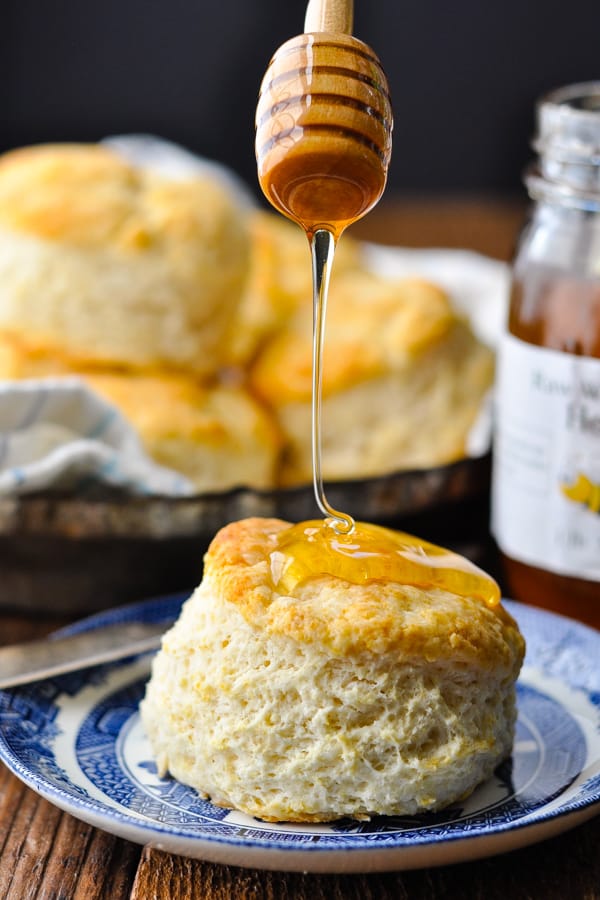
Ingredients in Buttermilk Biscuits
- All-purpose flour: I prefer an extra-fine soft winter wheat flour made by White Lily. This low-protein, low-gluten flour gives Southern buttermilk biscuits that perfectly crisp-on-the-outside, light-on-the-inside texture.
- Baking powder and baking soda: the leavening that helps the biscuits rise.
- Kosher salt
- Sugar: just enough, but not so much that the biscuits will taste sweet
- Butter: for great flavor! Make sure that it’s very cold (or frozen)
- Shortening (or lard): for puff! Keep this very cold, too!
- Buttermilk: for its acidity, as well as its fat and liquid content. In conjunction with the leavening agents, the acidity helps the biscuits rise. The buttermilk also gives the biscuits a nice, subtle tanginess and a tender crumb. Keep the buttermilk nice and cold before adding it to the dough!
How to Make Buttermilk Biscuits from Scratch
Buttermilk biscuits made a regular appearance on our weekend breakfast table when I was growing up. Both my mom and my dad perfected their recipe over the years, using a juice glass to pop out the round little gems on a floured countertop before church on Sundays. Today, I serve biscuits to my own family at least once a week — most often in the bread basket at dinner. No matter which entrée I’m offering, I know that the boys won’t go to bed hungry if these easy buttermilk biscuits are on the menu!
Step 1: Sift Together Dry Ingredients
In a large bowl, sift together the flour, baking powder, baking soda, salt, and sugar.
Step 2: Cut in Butter and Shortening
Use a pastry cutter or two forks to cut the butter and shortening into the dry ingredients until completely incorporated and it looks like coarse meal. You will still see flecks of butter and shortening throughout, which is good!
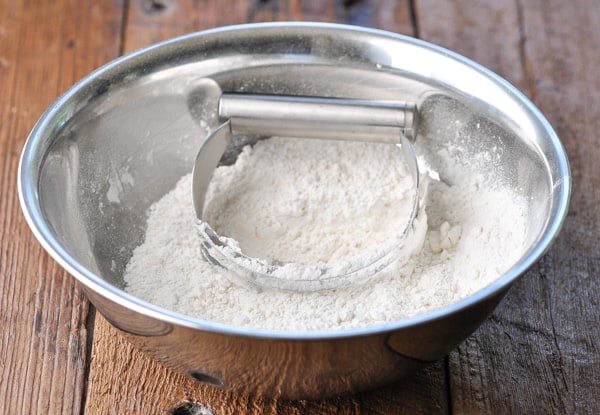
Step 3: Add Buttermilk
Gradually add the buttermilk, stirring with a wooden spoon until a dough forms.
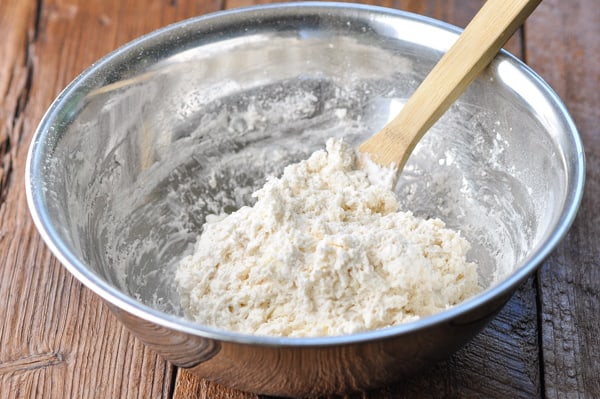
Step 4: Cut Out Biscuits
Turn the dough onto a lightly floured surface, and knead the dough for 1 minute (folding it over on itself). This process will help add those flaky layers to the biscuits. Feel free to flour your hands and the countertop, as necessary, to prevent the dough from sticking.
Then pat the dough to ¾-inch thickness and use a biscuit cutter to cut out rounds. I like to use a 2-inch or 2 ½-inch cutter, which yields about 8 smaller biscuits or 6-7 larger biscuits.
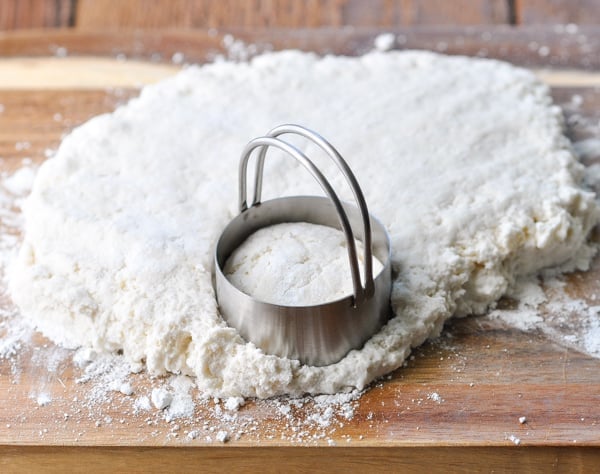
Step 5: Bake
Arrange the biscuits on a parchment-lined baking sheet or round cake pan with the sides of the biscuits touching each other. Brush the tops with a little bit of melted butter (this will help them brown in the oven).
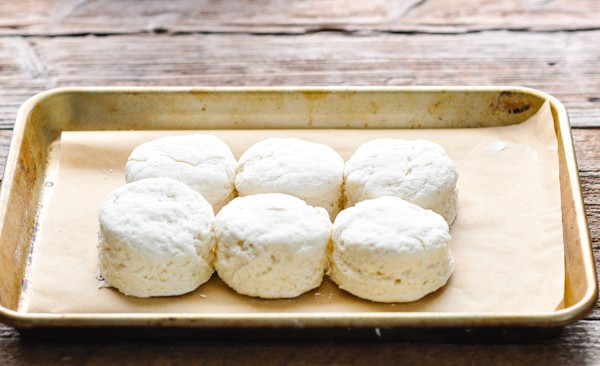
Bake in a 450-degree F oven for 10-12 minutes. The biscuits are done when the tops are golden brown and you can see that the inside layers are cooked through — not doughy or wet. Once they come out of the oven, brush the biscuits with additional melted butter (for great flavor), and serve warm!
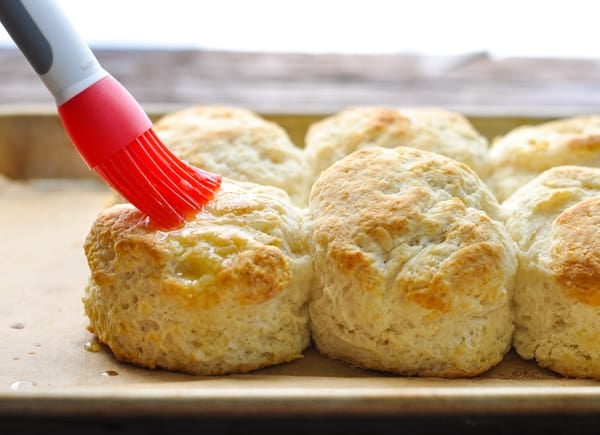
What to Serve with Southern Buttermilk Biscuits
Biscuits are a staple in many homes because they’re so versatile! Serve them on their own for breakfast with butter and honey, honey butter, jam, or apple butter. Add eggs on the side, use them to make an egg sandwich with sausage, bacon or cheese, or stir up a skillet of sausage gravy. In Virginia, country ham biscuits are a classic snack or meal at any time of day!
On the dinner table, here are a few entrées that go well with Southern buttermilk biscuits:
- Crispy Fried Chicken
- Pecan-Crusted Chicken
- Virginia Crab Imperial
- Oven BBQ Pork Chops
- Southern Chicken Salad
- Crock Pot Chicken and Gravy
- Grilled Pork Tenderloin
- Oven BBQ Chicken Breast
- Shrimp and Grits
- Slow Cooker Cowboy Pork and Beans
- Cornflake Chicken
- Crock Pot Ribs
- Pulled BBQ Chicken in the Crock Pot
- Crab Cakes
- Shrimp Creole
- Beef Barbecue
- Chili con Carne or “Good Luck” Southern Chili
- Smothered Pork Chops
- Southern Fried Catfish
- Sheet Pan Low Country Boil
- Smoked Sausage Pasta Bake
- Sweet Heat Southern Glazed Salmon
- Mississippi Roasted Pork Shoulder
Southern Buttermilk Biscuits FAQs
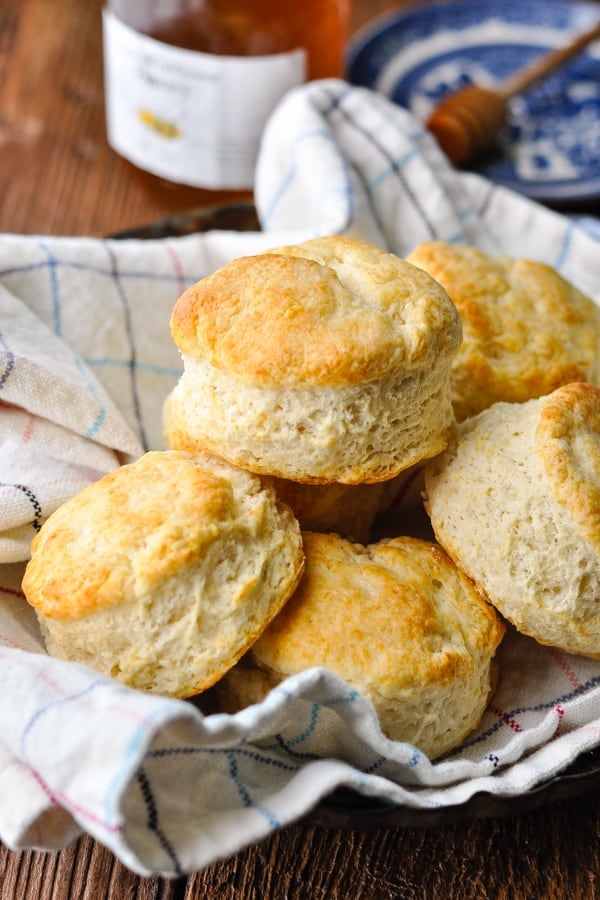
Can buttermilk biscuits be made ahead of time?
Yes! While they’re best served warm, straight from the oven, you can bake the biscuits up to 3 days in advance and store them in an airtight container at room temperature.
Reheat day-old biscuits by placing them on a baking sheet in a 300-degree F oven for about 10 minutes.
Can you freeze homemade biscuits?
Absolutely. Allow the biscuits to cool to room temperature, then wrap tightly in an airtight container or Ziploc freezer bag and store in the freezer for up to 3 months. Thaw on the counter overnight or in the microwave for a few seconds.
Should I use shortening, lard, or butter in Southern buttermilk biscuits?
This is the buttermilk biscuit recipe that I grew up with, but with one exception: I add Crisco shortening, whereas my parents use all butter. The most traditional Southern home cooks will tell you that old-fashioned buttermilk biscuits were made with lard, which is a pork product and therefore has a nice flavor. You can substitute with lard instead of shortening in this recipe, if that’s your preference. The shortening (or lard) helps the biscuits get nice and puffy in the oven, while the butter adds great flavor. As a result, I think the best Southern biscuits include both shortening (or lard) and butter.
If you only have butter in your house, you can omit the shortening and just use ¼ cup of salted butter.
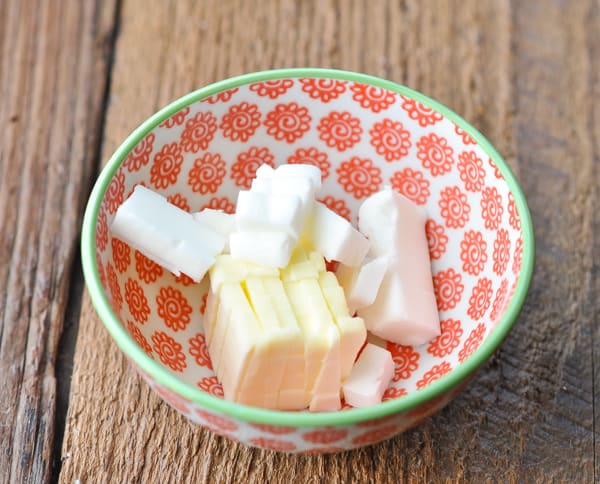
What does buttermilk do for biscuits?
Buttermilk is a classic Southern pantry staple that we always keep on hand! From fluffy pancakes to salad dressing, hoe cakes to fried chicken, it’s an important ingredient in so many of our favorite recipes — including these flaky buttermilk biscuits! The buttermilk serves a couple of purposes in an old-fashioned biscuit recipe that you can’t achieve with a regular milk:
- Flavor: the buttermilk gives the biscuits a nice, subtle tanginess
- Acidity: the acid in buttermilk helps the biscuits rise, because the acid from the buttermilk reacts with the alkaline baking soda, causing it to give off carbon dioxide. Baking powder will also react with buttermilk’s acidity to a small degree.
The amount of buttermilk that you need will vary, depending on the day. Start with ¾ cup, and then add more if the dough feels too dry and crumbly. If it’s humid or rainy, there’s already moisture in the air and in the flour, so you will likely need less liquid in your dough. On a cold, dry winter day, you may need a full cup of buttermilk to bring the dough together.
I get my buttermilk at a local country market near our house — and this is the REAL stuff — the liquid that runs off a batch of fresh butter. It makes the most delicious biscuits and cornbread! The buttermilk that you buy in a grocery store is probably just cultured milk (check the label) — which is a far cry from the real thing. If you have access to a local dairy or similar small market, I highly recommend getting your hands on the ultra-thick, ultra-rich buttermilk that will truly make your homemade biscuits stand out.
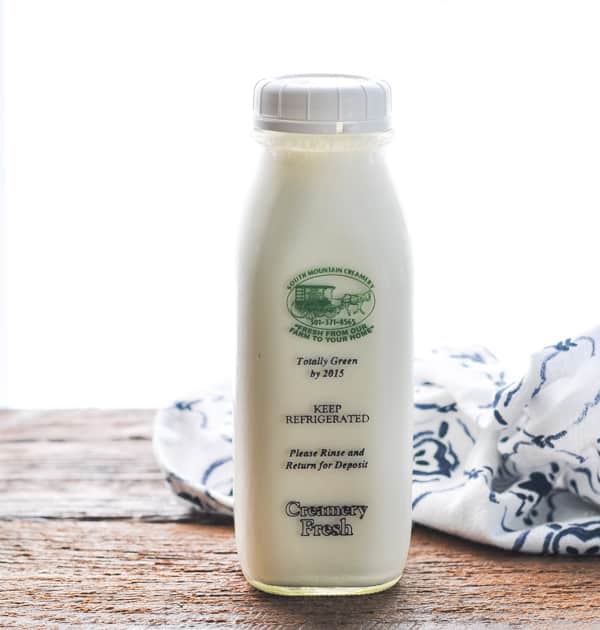
At what temperature do you bake Southern buttermilk biscuits?
It’s important to bake the biscuits in a very hot oven — 450 degrees F — which helps the biscuits rise quickly. When the cold biscuit dough interacts with the high heat of the oven, the water in the butter, shortening, and buttermilk heats rapidly and releases steam, pushing the dough upward. If an oven is set at a lower temperature (such as 350 or 400 degrees F), the fat inside the dough heats too slowly and melts before the biscuits can fully rise.
Tips for the Best Homemade Southern Biscuits
- Keep the ingredients COLD. It’s really important for the butter, shortening and buttermilk to stay as cold as possible when preparing biscuits. Leave them in the refrigerator until the last possible minute, and try not to touch the dough too much with your fingers, which can cause the butter and shortening to start to melt. You want those little pieces of butter and shortening to melt in the oven, releasing steam and reacting with the baking soda to form bubbles of carbon dioxide, which help the biscuits rise a mile high!
- Grate Frozen Butter. My dad always freezes his butter and grates it into the dry ingredients, rather than cutting it in with a pastry cutter or forks. Feel free to use that trick to keep your butter (and shortening) really cold, too!
- Knead the Dough. By folding the dough over itself (or “laminating”) for about a minute, you’ll add those nice flaky layers to the biscuits. No need for any fancy process or technique — just push out, fold back over on itself, and repeat. Don’t do this for too long, though, or you’ll get the dough too warm.
- Don’t Twist the Biscuit Cutter. Firmly press the cutter down into the dough, but don’t actually twist. Twisting the biscuit cutter seals off the edges of the biscuits and they therefore will not rise as high.
- Arrange the Biscuits with Sides Touching. Place the biscuits on the baking sheet so that they’re all touching their neighbors. This will help them “climb” in the oven so that you get that great, tall lift!
- Keep the Dough Cold. I’ll say it again — the key to tall, fluffy and puffy biscuits is cold ingredients. If you’re waiting for your oven to preheat, or if your kitchen is particularly warm, place the baking sheet with the unbaked biscuits into the refrigerator for about 5 minutes before baking. This will chill the dough so that the biscuits don’t spread in the oven.
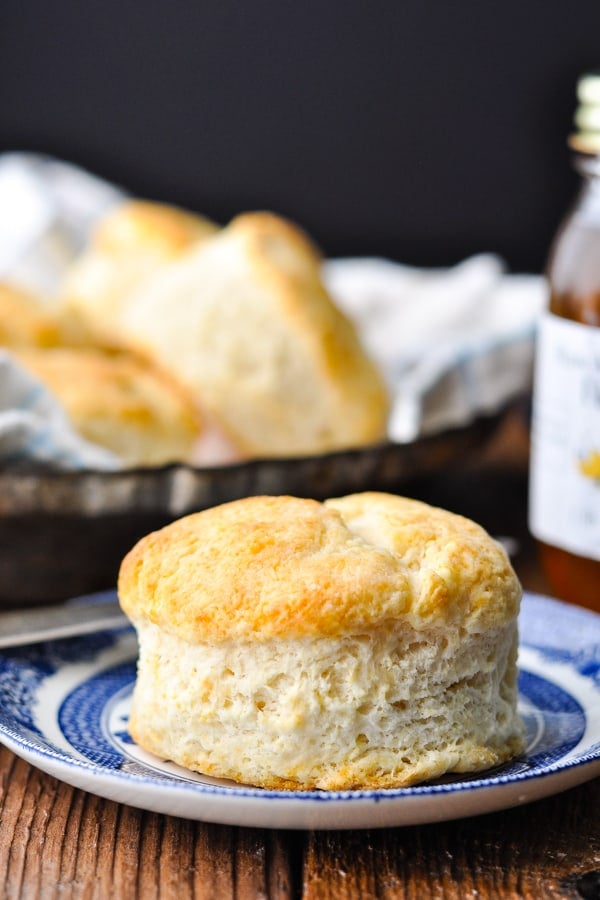
More biscuit recipes that you might enjoy:
- Aunt Bee’s 3-Ingredient Buttermilk Biscuits: the shortcut recipe that’s surprisingly effective when you’re short on time! This is a buttermilk biscuit recipe with self-rising flour.
- Cheddar Biscuits with Chives and Bacon: so many savory additions to this basic recipe!
- Cheddar Bay Biscuits: these buttermilk drop biscuits are just like Red Lobster’s. Perfect with a seafood supper or a bowl of soup!
- Biscuits and Gravy Casserole: this delicious brunch dish takes advantage of flaky Pillsbury biscuits for an easy shortcut!
- Strawberry Shortcake: a sweet biscuit recipe topped with macerated fresh strawberries.
- Grandma’s Sweet Potato Biscuits: an old-fashioned treat that’s perfect on a holiday table!
- Drop Biscuits: no cutting or rolling necessary!
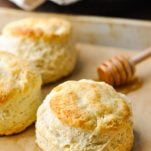
Southern Buttermilk Biscuits
Ingredients
- 2 cups all-purpose flour (I prefer White Lily brand)
- 4 teaspoons baking powder
- ¼ teaspoon baking soda
- ¾ teaspoon kosher salt
- 1 teaspoon sugar
- 2 tablespoons salted butter, diced into small pieces and chilled, plus about 2 tablespoons of melted butter for brushing tops
- 2 tablespoons shortening, diced into small pieces and chilled (or sub with lard)
- ¾ – 1 cup cold buttermilk
Instructions
- Preheat oven to 450 degrees F. Line a baking sheet with parchment paper; set aside.
- In a large bowl, sift together flour, baking powder, baking soda, salt and sugar. Use a pastry cutter or two forks to cut the butter and shortening into the flour mixture until incorporated and the mixture resembles coarse meal. You will still see flakes of butter and shortening throughout, which is good!
- Gradually add the buttermilk, stirring with a wooden spoon until a fairly wet, sticky dough forms. Turn out onto a lightly floured surface and knead for about 1 minute (folding the dough back over on itself), adding flour to the counter and your hands, as necessary, to prevent sticking. Pat to ¾-inch thickness. Use a biscuit cutter to cut out rounds (I use either a 2 or 2 ½ -inch cutter). Firmly press the cutter down into the dough, but do not twist. Twisting the biscuit cutter seals off the edges of the biscuits and they therefore will not rise as high.
- Arrange biscuits (with sides touching) on the parchment-lined baking sheet or in a parchment-lined round cake pan. Place the tray of biscuits in the refrigerator for about 5 minutes (if you have time) to chill before popping them in the oven. Brush the tops of the biscuits with a little bit of the melted butter.
- Bake for 10-12 minutes, or until tops are golden brown. Brush the tops with additional melted butter and serve warm.
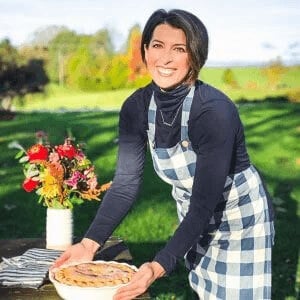
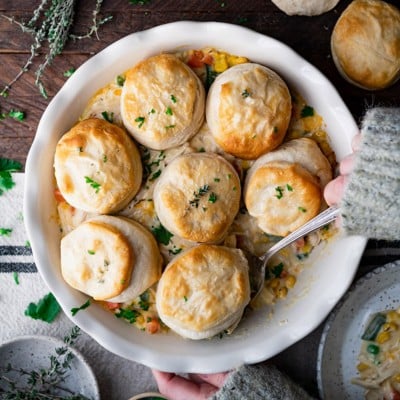
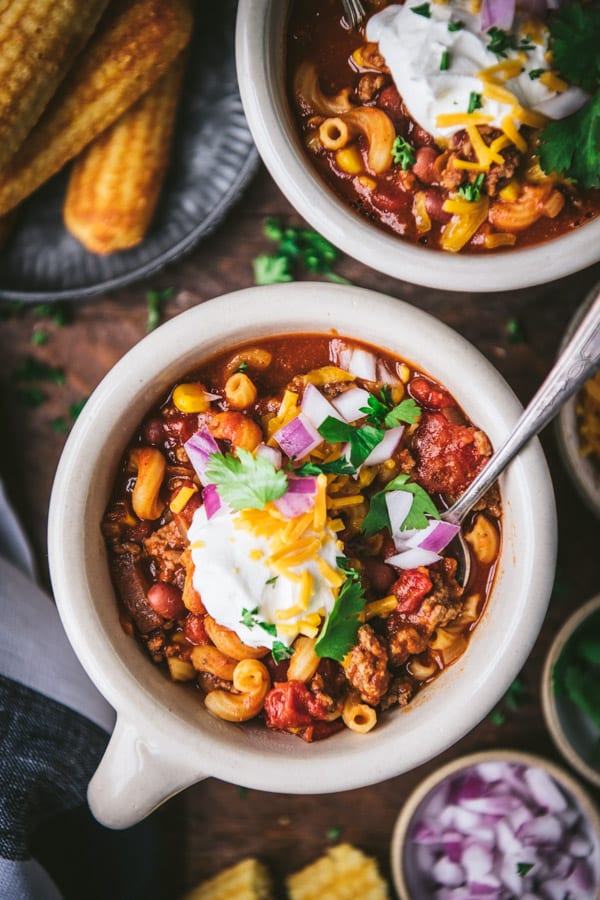
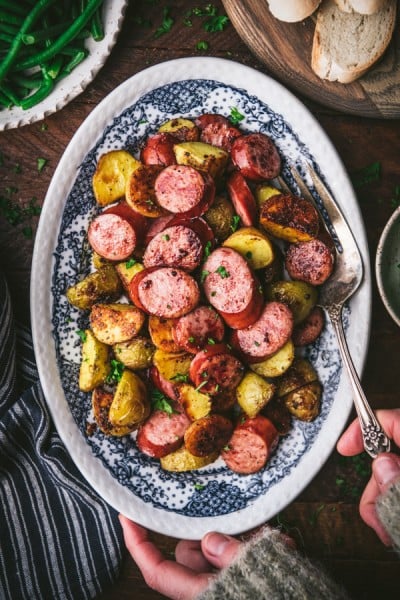








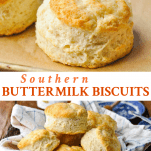
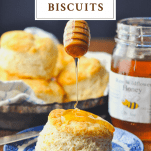
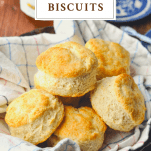
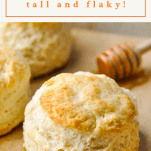
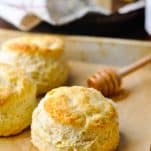
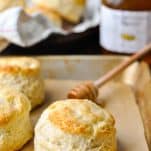
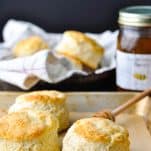
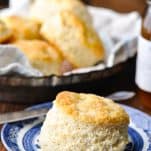
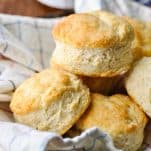
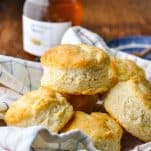
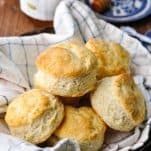
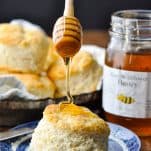
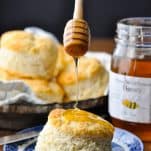
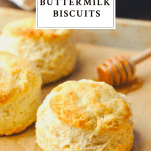
Pretty! This has been an incredibly wonderful article. Thanks for supplying this information.
These buscuits are amazing! I did have to add a little more shortening (was about 1/3 cup total) and double the cold butter, but other than that these turned out so great!
Thanks, Atalie!
Blair my name is Al an biscuits are a real challenge to me. I have benn baking bread for a number of years which is a different game. I have read your artical and will work at the points you have mentioned. I want so much to learn how to do this. I was born and raised on a dairy farm in NewEngland where yearst rolls were king along with baked beans or sometimes brown bread wich is steameed in a can but not biscuits, they were not part of my culture. All that I read says buscuits are a learning thing because when I started this I only made great buttons. Thank-you for for your advice; I`m going keep up the practice. Thier is one other thing that I have read, it is southern cooks use a low glutin flour,or mix cake flour with all purpose flour. I`m trying everything. Thangs AL
Hi, Al! Good luck! Just keep practicing and it will become second nature. I love White Lily flour for my biscuits. 🙂